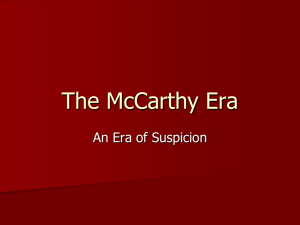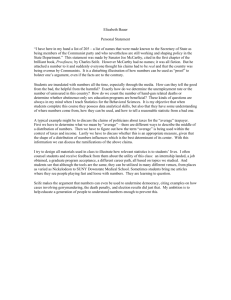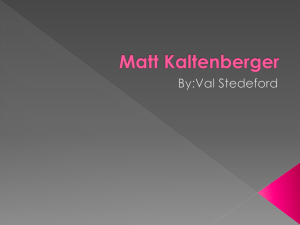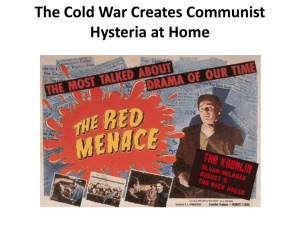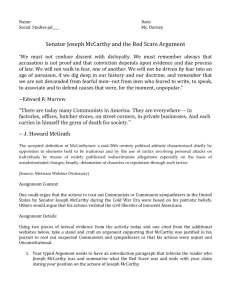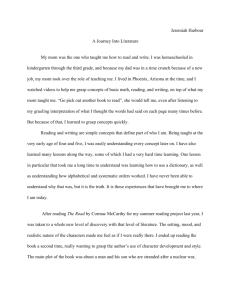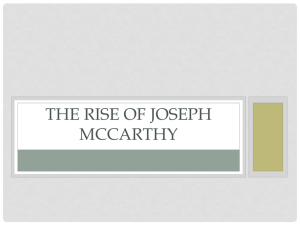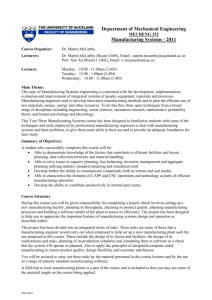Introduction to Security
advertisement
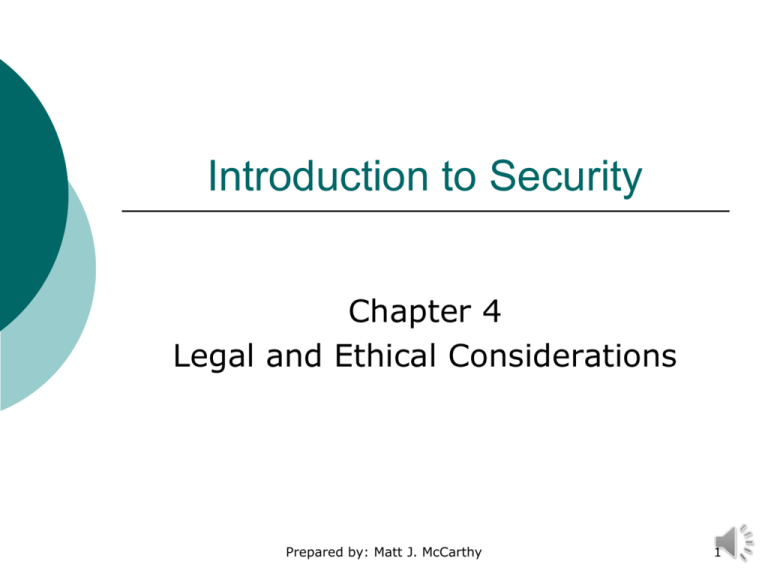
Introduction to Security Chapter 4 Legal and Ethical Considerations Prepared by: Matt J. McCarthy 1 Law & Liability in the U.S. Criminal Law: deals with offenses against the public (crimes) and fixes punishments for them Civil Law: deals with offenses against individuals, called “torts”, and seeks restitution for the victim Prepared by: Matt J. McCarthy 2 3 Categories of Civil Offenses: Strict liability – refers to instances where a person is held liable even though they not have knowingly done anything wrong Intentional Tort – an illegal act committed on purpose; may be both criminal and civil in nature Negligence – a failure to use due care to prevent foreseeable injury/ damages Prepared by: Matt J. McCarthy 3 Elements of Negligent Liability o There are differences from state to state in regards to what constitutes negligent liability. o There are, however, 5 basic elements to most definitions of negligent liability… Prepared by: Matt J. McCarthy 4 Elements of Negligent Liability Existence of some duty owed Foreseeable likelihood of the incident occurring Failure to meet a reasonable standard of care Proximate results – injury resulted from the failure to protect Damages Prepared by: Matt J. McCarthy 5 Common Civil Lawsuits Brought Against Private Security: In order for private security to protect itself against lawsuits, it is imperative that they understand what lawsuits are commonly brought against them. In this way, we can structure training to those areas that we typically encounter legal problems in. Prepared by: Matt J. McCarthy 6 Common Civil Lawsuits Brought Against Private Security: Assault & Battery Defamation False Imprisonment Intentional Infliction of Emotional Distress Invasion of Privacy Malicious Prosecution Negligence Prepared by: Matt J. McCarthy 7 The Civil Rights Act - Section 1983 This act, passed in 1871, says that anyone acting under the authority of local or state law who violates another person’s constitutional rights, can be sued. Prepared by: Matt J. McCarthy 8 The Use of Force Security officers are sometimes required to use force to do their jobs. Anytime an officer uses force, they greatly increase their risk of being sued. Thus, it is imperative that officers follow a use of force continuum. Prepared by: Matt J. McCarthy 9 Use of Force Continuum Prepared by: Matt J. McCarthy 10 Liability and Armed Personnel Security officers are working, much like their law enforcement counterparts, in an increasingly violent society. This means that the likelihood of an officer having to use a firearm may be increasing. Some agencies are turning to less lethal weapons to enhance security. Prepared by: Matt J. McCarthy 11 Less Lethal weapons These are weapons that are not designed to kill – however, death may result from their use if used improperly, enhancing the need for training. CN & CS tear gas OC (oleoresin capsicum) spray Tasers Projectile Launchers Specialty impact munitions such as bean bag rounds, flexible baton rounds Prepared by: Matt J. McCarthy 12 Trends in Security Liability Lawsuits The increase in exposure and importance of security since 9/11 has had a twofold effect on the industry. Along with this gain in importance, the industry has also become a greater target for lawsuits. Prepared by: Matt J. McCarthy 13 Lawsuit trends: Inadequate premises security – the number one cause for liabilityrelated lawsuits Crimes committed by employees – usually labeled as negligent hiring, retention or supervision Prepared by: Matt J. McCarthy 14 Steps for Reducing Liability: Hiring – take care to hire trustworthy, qualified individuals. Setting minimum standards for job performance Establishing clear policies and procedures Training Insurance Create a liability checklist Prepared by: Matt J. McCarthy 15 If you are sued… Common Defenses: Did not intend to deprive the plaintiff of a constitutional right Acted in good faith Used reasonable judgment at the time and with valid authority Prepared by: Matt J. McCarthy 16 Ethics “There is no right way to do a wrong thing…” Ethics refers to standards or principles of fair, honest conduct. This may include: A system of moral principles or values Rules or standards governing the conduct of the profession Accepted standards of right and wrong Prepared by: Matt J. McCarthy 17 Ethics Many questions of ethics include “morals”. The term “morals” is open to interpretation, and often are what people refer to as their conscience. Moral standards may be: Constructed by an individual Set forth by society or culture Laid down by a religious body Prepared by: Matt J. McCarthy 18 Developing Ethics 3 Personal ethics-check questions: Is it legal? Is it balanced? How does it make me feel about myself? Prepared by: Matt J. McCarthy 19 Developing Ethics 3 Organizational ethics-check questions: Are we delivering what we promise in terms of quality and customer service? Are we selling a product or service that is harmful to society? Are we honest in the way we do business? Prepared by: Matt J. McCarthy 20 Prepared by: Matt J. McCarthy 21 Ethics and decision making Pollock (pp. 21-22) suggests five analytical steps that might be taken to clarify a dilemma. Following such a guideline can help us when dealing with these ethical issues and dilemmas. Prepared by: Matt J. McCarthy 22
